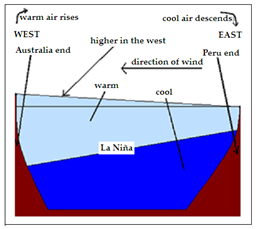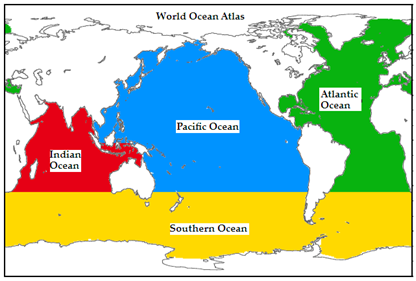The heat of global warming is getting stowed in the Indian Ocean, says S.Ananthanarayanan.
Despite global inaction to contain the emission of greenhouse gases, and even sizeable rise in the level of emissions during the last decade, it is seen that there has been nearly no increase in the surface temperature of the earth. But scientists have warned that this is no reason to think that matters are under control. The reason that the ambient temperature has not been rising is that in the last decade the deep sea, which is cool and has great heat capacity, has been absorbing global heat.
Sang-Ki Lee,Wonsun Park, Molly O. Baringer, Arnold L. Gordon, Bruce Huber and Yanyun Liu, of Miami, the University of Columbia and Kiel, Germany, in their letter in the journal, Nature Geoscience, describe how a persistent reverse El Niño effect results in the surface of the Pacific ocean cooling down and absorbing heat from the atmosphere. As there is no evidence of the surface of the Pacific Ocean getting warmer, the team has searched and found that the heat is getting passed on to the Indian Ocean, which keeps the heat in its upper 700 metres.
El Niño
The El Niño effect is the phenomenon of the eastern side, that is the South America side, of the Pacific Ocean, which is normally cool and dry, getting warm and humid with rain, while the western side, which is the warm, Australia side, gets cooler than it usually is. In normal years, Peruvian coast of South America is cool and the sea near Australia is warm. The air over Australia gets warmed and rises, while trade winds blow westward from the Peruvian end. The westward winds over the ocean cause the water to shore up at the western end. The weight of higher water (it is higher by about one metre) near Australia causes cooler, nutrition rich, deeper water to ‘well up’ at the Peru end, where the weather stays dry and there is great fishing.

But every once in a few years, ocean currents bring warm water to the eastern coast. This blocks the trade wind and the ‘up welling’, and ruins the fishing, but there is warmth and moisture and luxurious vegetation in parts that are normally arid and bare. As this usually happens around Christmas time, the phenomenon is likened to the arrival of baby Jesus and has been named El Niño, or the (Holy) Little One.
La Niña and the atmosphere
The mean temperature of the atmosphere is a result of warming by the sun from above and by radiation from the earth or the sea, from below. Now, when the surface of the sea becomes unusually cool, as during La Niña, the sea does not radiate towards the atmosphere and atmosphere loses heat to the sea, and cools down. The warm and cool spells in the Pacific alternate every few years, but since the beginning of this century, there has been an unusually long spell of La Niña conditions. The surface of the Pacific Ocean has thus been cool for all these years and this is the reason that the lower atmosphere has been losing heat and rise in global warming has not been readily apparent.

San Ki Lee and colleagues worked out the arithmetic of how heat is distributed among the earth’s oceans, or the Global Heat Budget, with the help of the World Ocean Atlas. This is a display of the major ocean basins, the Atlantic, Pacific and Indian Oceans, separated by land masses, and the Southern Ocean, below. The record of the annual addition to Oceanic Heat Content (OHC), or the OHC700, which is the heat content in the upper 700 metres, is shown in the table, in terms of a unit that indicates the relative value:

The figures show that while there has been increase of the global heat content, there is net reduction in the Pacific and Atlantic Oceans, with increase in the Southern Ocean and sharp increase in the Indian Ocean. Independent studies have shown that the Atlantic and Southern Oceans had major inflow of heat, the effect not being visible in OHC700 of the Atlantic because heat has been transferred to the deep ocean, below 700 metres. But the anomaly remains of the Pacific Ocean, despite high intake in the eastern Pacific, and rise in the Indian Oceans, and this formed the subject of the scientists’ study.
Horizontal flow
The study used global general circulation model and simulated heat transport processes to correspond to the observed changes. The simulations correctly reflect the increased heat uptake, globally, on account of increased man-made addition to greenhouse gas content of the atmosphere, speeding up, and also checked by greater radiation by the warmer sea, in the last decade. The Indian Ocean also has low heat intake during the earlier period, and sharp increase after the turn of the century.
These changes are reflected by the simulations, but the detailed heat budgets analyses show that the warming of the Indian Ocean is not on account of surface heating but is a result of horizontal flows. Further analysis shows that the heat intake was from the Pacific Ocean, via the passage to the Indian Ocean through the Indonesian archipelago. And this intake more than compensated the increased loss of heat during the period from the Indian Ocean to the Southern Ocean.
These changes are mirrored in the changes in the Pacific Ocean. There was great increase in the heat input, on account of the sustained La Niña conditions, but this did not lead to rise in surface temperature, rather the contrary, which would be a feature of La Niña, because of the loss of heat to the Indian Ocean.
The study shows the Indian Ocean area as important in the global ocean heat distribution and underlines the need to understand the mechanisms at work. An outcome of better understanding may be to know whether the heat stored in the Indian Ocean may be returned to the atmosphere once the La Niña conditions in the Pacific relax, or if it may get sequestered in the deep sea.
------------------------------------------------------------------------------------------